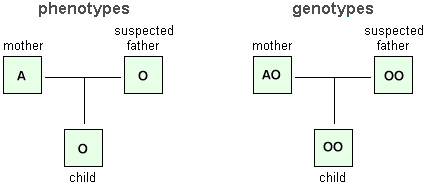
Bombay Phenotype
It is important to be cautious in predicting the ABO blood type of children based on the phenotypes of their parents. This is due to the fact that a third antigen (H) on the surface of red cells can prevent the expected ABO blood type from occurring.Normally, if an A blood type mother has an O type child, the father is expected to be type O or at least to carry the O allele (OO, AO, or BO genotype).

The child has inherited an O allele from both parents. However, an O blood type child can also be born to parents who do not have the O allele if a recessive form of the allele for the H antigen also is inherited from both parents.
The H antigen is a precursor to the A and B antigens. For instance, the B allele must be present to produce the B enzyme that modifies the H antigen to become the B antigen. It is the same for the A allele. However, if only recessive alleles for the H antigen are inherited (hh), as in the case above, the H antigen will not be produced. Subsequently, the A and B antigens also will not be produced. The result is an O phenotype by default since a lack of A and B antigens is the O type. This seemingly impossible phenotype result has been referred to as a Bombay phenotype
because it was first described in that Indian city.
The ABO blood system is further complicated by the fact that there are two subtypes of type A and two of AB. These are referred to as A1, A2, A1B, and A2B.
For a more in-depth biochemical explanation of what the ABO alleles are actually doing to cause the ABO blood types, refer to the Related Internet Sites section of this tutorial.
Copyright © 1999-2012 by Dennis O'Neil. All rights reserved.